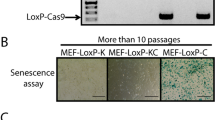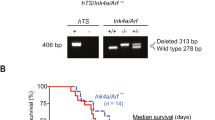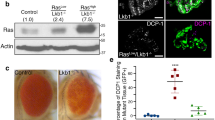Abstract
Mounting genetic evidence suggests that each product of the Ink4a/Arf locus, p16INK4a and p19ARF, possesses tumor-suppressor activity (Kamijo et al., 1997; Krimpenfort et al., 2001; Sharpless et al., 2001a). We report the generation and characterization of a p19ARF-specific knockout allele (p19ARF−/−) and direct comparison with mice and derivative cells deficient for p16INK4a, both p16INK4a and p19ARF, and p53. Like Ink4a/Arf−/− murine embryo fibroblasts (MEFs), p19ARF−/− MEFs were highly susceptible to oncogenic transformation, exhibited enhanced subcloning efficiency at low density, and resisted both RAS- and culture-induced growth arrest. In contrast, the biological profile of p16INK4a−/− MEFs in these assays more closely resembled that of wild-type cells. In vivo, however, both p19ARF−/− and p16INK4a−/− animals were significantly more tumor prone than wild-type animals, but each less so than p53−/− or Ink4a/Arf−/− animals, and with differing tumor spectra. These data confirm the predominant role of p19ARF over p16INK4a in cell culture-based assays of MEFs, yet also underscore the importance of the analysis of tumor suppressors across many cell types within the organism. The cancer-prone conditions of mice singly deficient for either p16INK4a or p19ARF agree with data derived from human cancer genetics, and reinforce the view that both gene products play significant and nonredundant roles in suppressing malignant transformation in vivo.
This is a preview of subscription content, access via your institution
Access options
Subscribe to this journal
Receive 50 print issues and online access
$259.00 per year
only $5.18 per issue
Buy this article
- Purchase on Springer Link
- Instant access to full article PDF
Prices may be subject to local taxes which are calculated during checkout



Similar content being viewed by others
References
Artandi SE, Alson S, Tietze MK, Sharpless NE, Ye S, Greenberg RA, Castrillon DH, Horner JW, Weiler SR, Carrasco RD and DePinho RA . (2002). Proc. Natl. Acad. Sci. USA, 99, 8191–8196.
Bachoo RM, Maher EA, Ligon KL, Sharpless NE, Chan SS, You MJ, Tang Y, DeFrances J, Stover E, Weissleder R, Rowitch DH, Louis DN and DePinho RA . (2002). Cancer Cell, 1, 269–277.
Bardeesy N, Bastian BC, Hezel A, Pinkel D, DePinho RA and Chin L . (2001). Mol. Cell. Biol., 21, 2144–2153.
Brenner AJ, Stampfer MR and Aldaz CM . (1998). Oncogene, 17, 199–205.
Brookes S, Rowe J, Ruas M, Llanos S, Clark PA, Lomax M, James MC, Vatcheva R, Bates S, Vousden KH, Parry D, Gruis N, Smit N, Bergman W and Peters G . (2002). EMBO J., 21, 2936–2945.
Eischen CM, Rehg JE, Korsmeyer SJ and Cleveland JL . (2002). Cancer Res., 62, 2184–2191.
Festing M . (1998). Mouse Genome Informatics Web Site. Vol. 2001 The Jackson Laboratory: Bar Harbor, Maine.
FitzGerald MG, Harkin DP, Silva-Arrieta S, MacDonald DJ, Lucchina LC, Unsal H, O'Neill E, Koh J, Finkelstein DM, Isselbacher KJ, Sober AJ and Haber DA . (1996). Proc. Natl. Acad. Sci. USA, 93, 8541–8545.
Foster SA, Wong DJ, Barrett MT and Galloway DA . (1998). Mol. Cell. Biol., 18, 1793–1801.
Hewitt C, Lee Wu C, Evans G, Howell A, Elles RG, Jordan R, Sloan P, Read AP and Thakker N . (2002). Hum. Mol. Genet., 11, 1273–1279.
Huot TJ, Rowe J, Harland M, Drayton S, Brookes S, Gooptu C, Purkis P, Fried M, Bataille V, Hara E, Newton-Bishop J and Peters G . (2002). Mol. Cell. Biol., 22, 8135–8143.
Huschtscha LI, Noble JR, Neumann AA, Moy EL, Barry P, Melki JR, Clark SJ and Reddel RR . (1998). Cancer Res., 58, 3508–3512.
Hussussian CJ, Struewing JP, Goldstein AM, Higgins PA, Ally DS, Sheahan MD, Clark WH, Jr, Tucker MA and Dracopoli NC . (1994). Nat. Genet., 8, 15–21.
Kamb A, Gruis NA, Weaver-Feldhaus J, Liu Q, Harshman K, Tavtigian SV, Stockert E, Day III RS, Johnson BE and Skolnick MH . (1994). Science, 264, 436–440.
Kamijo T, Bodner S, van de Kamp E, Randle DH and Sherr CJ . (1999). Cancer Res., 59, 2217–2222.
Kamijo T, Zindy F, Roussel MF, Quelle DE, Downing JR, Ashmun RA, Grosveld G and Sherr CJ . (1997). Cell, 91, 649–659.
Kannan K, Sharpless NE, Xu J, O'Hagan RC, Bosenberg M and Chin L . (2003). Proc. Natl. Acad. Sci. USA, 100, 1221–1225.
Kiyono T, Foster SA, Koop JI, McDougall JK, Galloway DA and Klingelhutz AJ . (1998). Nature, 396, 84–88.
Korgaonkar C, Zhao L, Modestou M and Quelle DE . (2002). Mol. Cell. Biol., 22, 196–206.
Krimpenfort P, Quon KC, Mooi WJ, Loonstra A and Berns A . (2001). Nature, 413, 83–86.
Lakso M, Pichel JG, Gorman JR, Sauer B, Okamoto Y, Lee E, Alt FW and Westphal H . (1996). Proc. Natl. Acad. Sci. USA, 93, 5860–5865.
Lin AW and Lowe SW . (2001). Proc. Natl. Acad. Sci. USA, 98, 5025–5030.
Lowe SW and Sherr CJ . (2003). Curr. Opin. Genet. Dev., 13, 77–83.
Mao L, Merlo A, Bedi G, Shapiro GI, Edwards CD, Rollins BJ and Sidransky D . (1995). Cancer Res., 55, 2995–2997.
Munro J, Stott FJ, Vousden KH, Peters G and Parkinson EK . (1999). Cancer Res., 59, 2516–2521.
Olson DC, Marechal V, Momand J, Chen J, Romocki C and Levine AJ . (1993). Oncogene, 8, 2353–2360.
Pomerantz J, Schreiber-Agus N, Liegeois NJ, Silverman A, Alland L, Chin L, Potes J, Chen K, Orlow I, Lee HW, Cordon-Cardo C and DePinho RA . (1998). Cell, 92, 713–723.
Randerson-Moor JA, Harland M, Williams S, Cuthbert-Heavens D, Sheridan E, Aveyard J, Sibley K, Whitaker L, Knowles M, Newton Bishop J and Bishop DT . (2001). Hum. Mol. Genet., 10, 55–62.
Randle DH, Zindy F, Sherr CJ and Roussel MF . (2001). Proc. Natl. Acad. Sci. USA, 98, 9654–9659.
Rheinwald JG, Hahn WC, Ramsey MR, Wu JY, Guo Z, Tsao H, De Luca M, Catricala C and O'Toole KM . (2002). Mol. Cell. Biol., 22, 5157–5172.
Rizos H, Puig S, Badenas C, Malvehy J, Darmanian AP, Jimenez L, Mila M and Kefford RF . (2001). Oncogene, 20, 5543–5547.
Serrano M, Lee H, Chin L, Cordon-Cardo C, Beach D and DePinho RA . (1996). Cell, 85, 27–37.
Serrano M, Lin AW, McCurrach ME, Beach D and Lowe SW . (1997). Cell, 88, 593–602.
Sharpless NE, Alson S, Chan S, Silver DP, Castrillon DH and DePinho RA . (2002). Cancer Res., 62, 2761–2765.
Sharpless NE, Bardeesy N, Lee KH, Carrasco D, Castrillon DH, Aguirre AJ, Wu EA, Horner JW and DePinho RA . (2001a). Nature, 413, 86–91.
Sharpless NE, Ferguson DO, O'Hagan RC, Castrillon DH, Lee C, Farazi PA, Alson S, Fleming J, Morton CC, Frank K, Chin L, Alt FW and DePinho RA . (2001b). Mol. Cell, 8, 1187–1196.
Sharpless NE, Kannan K, Xu J, Bosenberg M and Chin L . (2003). Oncogene. (in press).
Sherr CJ . (2001). Cell, 106, 531–534.
Sherr CJ and DePinho RA . (2000). Cell, 102, 407–410.
Stone S, Jiang P, Dayananth P, Tavtigian SV, Katcher H, Parry D, Peters G and Kamb A . (1995). Cancer Res., 55, 2988–2994.
Sviderskaya EV, Gray-Schopfer VC, Hill SP, Smit NP, Evans-Whipp TJ, Bond J, Hill L, Bataille V, Peters G, Kipling D, Wynford-Thomas D and Bennett DC . (2003). J. Natl. Cancer Inst., 95, 723–732.
Tolbert D, Lu X, Yin C, Tantama M and Van Dyke T . (2002). Mol. Cell. Biol., 22, 370–377.
Weber JD, Kuo ML, Bothner B, DiGiammarino EL, Kriwacki RW, Roussel MF and Sherr CJ . (2000). Mol. Cell. Biol., 20, 2517–2528.
Wei W, Hemmer RM and Sedivy JM . (2001). Mol. Cell. Biol., 21, 6748–6757.
Zhu J, Woods D, McMahon M and Bishop JM . (1998). Genes Dev., 12, 2997–3007.
Zindy F, Quelle DE, Roussel MF and Sherr CJ . (1997). Oncogene, 15, 203–211.
Acknowledgements
We wish to thank R Carrasco and B Bachoo for assistance with mouse histopathology; C Torrice, S Alson, Aguirre, S Chan, K Chin, and J Horner for advice and reagents; and C Sherr and T Van Dyke for comments on the manuscript. This work was supported by grants from the Howard Hughes Medical Institute, National Institutes of Health and American Cancer Society. RAD is an American Cancer Society Research Professor. NES is a Sydney Kimmel Foundation for Cancer Research Scholar.
Author information
Authors and Affiliations
Corresponding author
Rights and permissions
About this article
Cite this article
Sharpless, N., Ramsey, M., Balasubramanian, P. et al. The differential impact of p16INK4a or p19ARF deficiency on cell growth and tumorigenesis. Oncogene 23, 379–385 (2004). https://doi.org/10.1038/sj.onc.1207074
Received:
Revised:
Accepted:
Published:
Issue Date:
DOI: https://doi.org/10.1038/sj.onc.1207074
Keywords
This article is cited by
-
Targeting aging and age-related diseases with vaccines
Nature Aging (2024)
-
Aging microenvironment and antitumor immunity for geriatric oncology: the landscape and future implications
Journal of Hematology & Oncology (2023)
-
ARF suppression by MYC but not MYCN confers increased malignancy of aggressive pediatric brain tumors
Nature Communications (2023)
-
Immortalized murine tenocyte cells: a novel and innovative tool for tendon research
Scientific Reports (2023)
-
Exploiting senescence for the treatment of cancer
Nature Reviews Cancer (2022)



